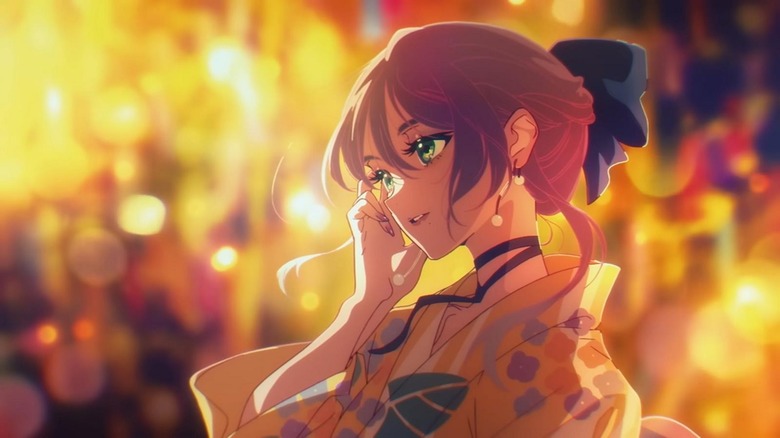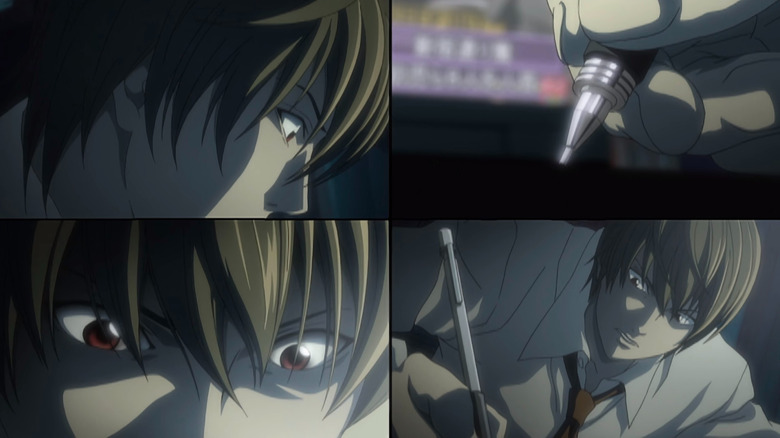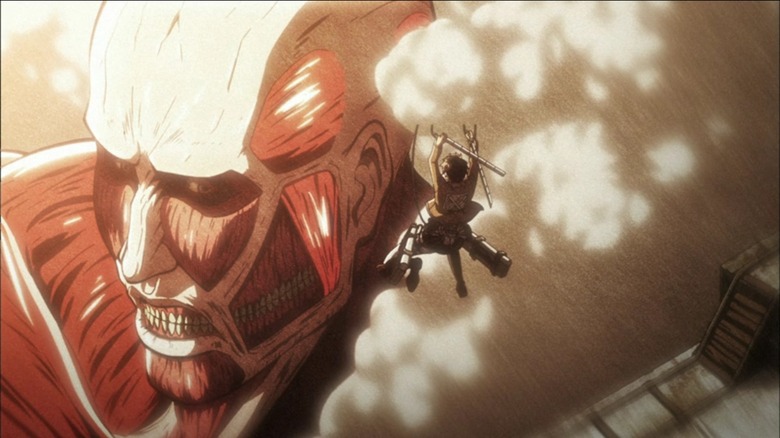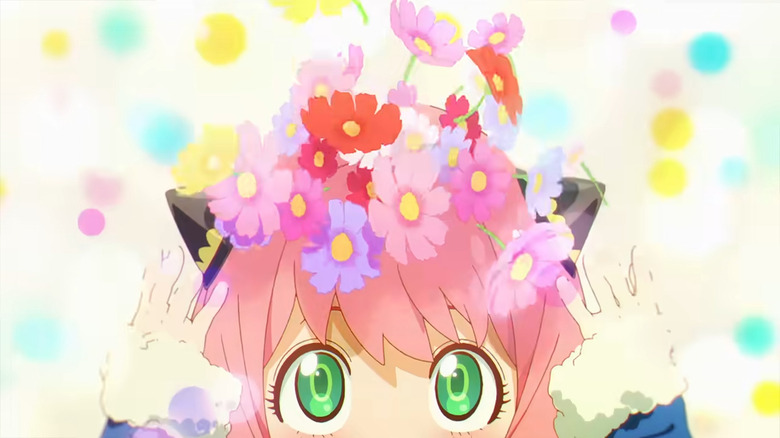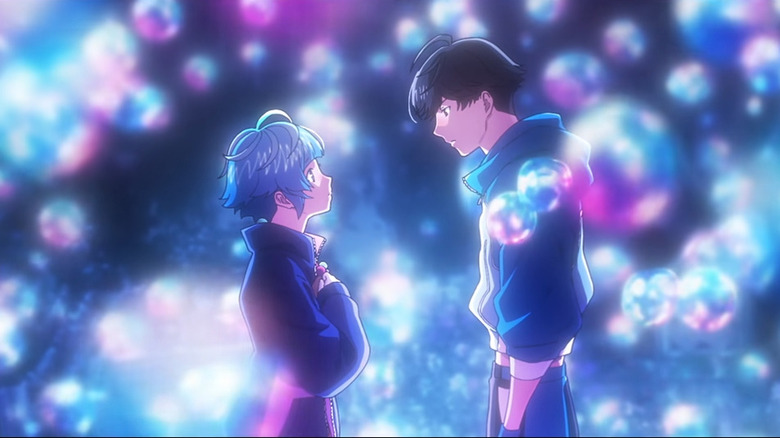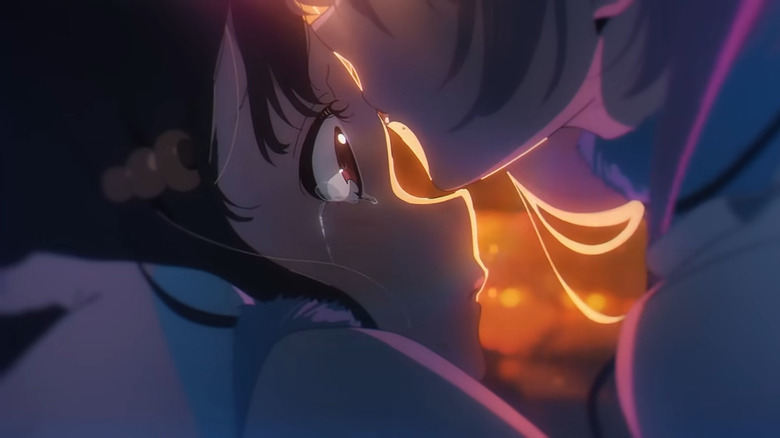The Director Of Death Note Is Telling Romance Stories Now, And Anime Isn't Ready
In the animated short film "COLORs," one of five created for Toho Animation's 10th anniversary, a high school girl discovers that her classmate presents as a woman outside of school. She follows them around the city, from a coffee shop to a festival to a forest bursting with fall colors. When they announce one day that they are transferring elsewhere, the girl is overcome with sorrow.
She leaves her apartment to go find them, perhaps to tell them how she really feels. But then, out of nowhere, a warning siren rings. The city bursts into flames as a great sphere hangs in the sky. Soldiers engage the unseen enemy. Amidst the chaos, the girl finds her former classmate and embraces her. Her classmate kisses her on the forehead, and then joins the army.
Most of "COLORs" works beautifully. Illustrator Mai Yoneyama invests the heroine's classmate with larger-than-life glamor but is careful to give the heroine personality via fashion choices and mannerisms. Yoneyama's work here nicely splits the difference between the youthful vibrancy of "YOKU" and the character exploration of her earlier collaboration "raison d'etre."
Meanwhile, Hiroyuki Sawano's music, featuring vocalist Motohiro Hara, reminds us that Sawano might be even better at pop songs than he is at the blaring action themes he's famous for. But the video's shift into military sci-fi happens so abruptly that I couldn't help but laugh. It's an unexpected turn that makes perfect sense when you consider the director of "COLORs": Tetsuro Araki, best known for action-packed thrillers like "Death Note" and "Attack on Titan."
I'll take a potato chip
Tetsuro Araki began his career at the famous studio Madhouse, where he worked among folks like Sayo Yamamoto ("Yuri on Ice!!") and Takayuki Hirao ("Garden of Sinners: Paradox Paradigm"). After contributing to the bombastic action series "Black Lagoon," he was tapped to direct the TV adaptation of the popular Shonen Jump comic "Death Note."
Araki knocked the assignment out of the park — the source material is entertaining in its own right, but the anime elevates scenes such as Light pridefully eating a potato chip to even greater dramatic heights. "Death Note" doesn't add up to much beyond "killing people is bad," but that simplicity gave Araki and his team plenty of opportunities to add their own flourishes to the story.
His first original project, though, played upon all his worst instincts. "Guilty Crown" was a science fiction series produced in 2011 by the famed Production I.G. Featuring a script by the writers of "Code Geass" and illustrations by Yamasaki "redjuice" Tomoyuki, the show had every chance of being a success. But while "Guilty Crown" sold reasonably well and had appealing visuals, the story and characters were a bust.
Araki's high-intensity direction only made the gaping holes in the plot and motivation that much tougher to ignore. By the time the hero Shu rode to the final battle on a segway, my friends had moved beyond yelling at "Guilty Crown" each week to laughing at its absurdities.
And eat it
That same dynamic would be replicated by 2013's "Attack on Titan," one of the biggest anime titles of the decade. Tetsuro Araki's crew of action animators at Studio WIT reinvented the rough but appealing source comic as a festival of 2D action tracked by a roving 3D camera. "Every bit of action is larger than life, never letting up for a second," said Callum May of The Canipa Effect.
"Attack on Titan" rode the blockbuster sensibilities of his crew to become a generational hit. But the show's stiff character acting and bizarre Titan designs made it an object of ridicule as well as praise, aided by the single-minded intensity of Araki's direction. The source material was already so loud that it left little room to turn up the dramatic volume. In his moment of triumph, Araki had reached a creative dead end.
Nine years later, in 2022, I found myself pleasantly surprised by the second opening credits sequence of "Spy x Family." It's a lovely, autumnal sequence that carefully depicts the love shared between the three main characters. At first, I thought it was the work of Shingo Yamashita, whose opening credits have been a boon to several recent titles adapted from the pages of Shonen Jump.
But no: this was Araki, proving himself to be just as capable of depicting intimacy as he was at violence. After years of being pegged as an action director, he had finally found a new niche for himself.
Broadening his viewpoint
Tetsuro Araki's pivot toward character relationships didn't come out of nowhere. After directing "Attack on Titan," Araki began work on a second original series, 2016's "Kabaneri of the Iron Fortress." "Kabaneri" resembled "Attack on Titan" on the surface, with its narrative of heroic soldiers on a train squaring off against a zombie army. But Araki had "Guilty Crown" in mind. When making that series, he told SUGOI JAPAN, he saw the plot as the most important aspect.
While making "Kabaneri," "for the first time, I thought deeply about how I could create characters that the audience would love." The heroine of "Kabaneri," Mumei, is immediately livelier than her "Guilty Crown" counterpart Inori. The hero Ikoma might be a rude nerd, but he never becomes a fascist dictator as Shu does. Best of all, their relationship features some real push and pull.
For inspiration, Araki turned to the works of Yoshiyuki Tomino, particularly "Mobile Suit Gundam." Back in 2014, he had the opportunity to storyboard episodes of Tomino's "Gundam Reconguista in G." Tomino covered Araki's storyboards in harsh critique, but Araki treasured all of it.
According to an interview at Full Frontal, Araki paid homage to Tomino by centering "Kabaneri" around a moving central location much like the White Base in the first "Gundam." But I can't help but wonder if Araki was also influenced by Tomino's focus on human connections. Tomino told him repeatedly, "You need to broaden your viewpoint." Judging from the projects that followed, Araki took Tomino's advice to heart.
'More of a utopia than a dystopia'
Tetsuro Araki's first original film, 2022's "Bubble," diverged immediately from "Attack on Titan" and "Kabaneri." The script featured input from Gen Urobuchi, whose tastes combined with Araki's ought to have resulted in a supremely gothic and self-serious film. Instead, "Bubble" was a sci-fi retelling of "The Little Mermaid" featuring teenage romance and parkour.
"This time around," Araki told Anime News Network, "we were trying to tell a very beautiful and ephemeral love story." Even more unusual was his claim that "we wanted this derelict, futuristic Tokyo to present itself as more of a utopia than a dystopia." "Attack on Titan," this was not. Instead, Araki and company could very well have had Makoto Shinkai's sci-fi romance "Your Name" in their sights.
Despite its high-profile creative team, "Bubble" earned mixed reviews. "Bubble's failure to connect is rooted in trying to be too many things at once and never quite excelling at any of them," wrote Lynzee Loveridge in her review at Anime News Network. Elsewhere, Rafael Motamayor wrote at Inverse that "the characters are just too flat to care about." Once again Araki and his team had failed to build a believable romance.
But his recent work has fared better. His opening credits for "Spy x Family," as I mentioned, are excellent. Also worth highlighting are his opening credits for the second season of "Vinland Saga," which depicts the show's central conflict through well-chosen (and original) visual metaphors. Frankly speaking, Araki may be at his best when working under somebody else's remit. His unrelenting approach can be exhausting at length but works wonders in small doses.
With COLORs, Araki is at his best and worst
"COLORs" represents Tetsuro Araki at his best and worst. The short features the dynamic moving camera of "Attack on Titan" as well as the vibrant lighting and world design of "Kabaneri." Mai Yoneyama's character designs become even more charismatic under his direction. The video's depiction of single-minded adolescent love lends itself well to Araki's skillset — after all, a high school crush hits as hard in the moment as an episode of "Attack on Titan."
But the short's sudden switch from youthful nostalgia to military action is just as unexpectedly hilarious as any scene from "Guilty Crown." Not to mention its uncomplicated valorization of the military. Only somebody like Araki could end a high school romance with a shot of the lead joining the armed forces, presented as if that was the central theme all along.
If it sounds like I dislike Araki as a director, that isn't exactly the case. I'm glad that he's trying new things, even if his efforts (like "Bubble") don't always work out. Araki could have continued to coast as the director of "Attack on Titan." But instead, he's stretching himself, collaborating with exciting young animators to prove that he's just as capable in other genres.
Certainly, he has his work cut out for him if he wants to compete with other folks in the Toho Animation short film collection — China's "Detarame na Sekai no Melodrama" is tough competition. But Araki's connections and technical skills are such that you can't ignore him. Sooner or later he'll land another popular success, perhaps this time with the appealing characters he's been angling for. When that happens, Makoto Shinkai better be ready.
